BUiD Harvard Referencing Guide: A Guide to Avoiding Plagiarism
VerifiedAdded on 2019/09/30
|39
|16181
|742
Homework Assignment
AI Summary
This document is a comprehensive guide to the Harvard author-date referencing system, designed to help students avoid plagiarism. It covers the fundamentals of referencing, including the importance of acknowledging sources, and provides detailed instructions on how to cite various types of sources, such as books, journal articles, websites, and other materials. The guide explains the principles of in-text citations (author-date), paraphrasing, and using quotations, as well as the structure and features of a reference list. It also addresses common questions about referencing and plagiarism. Developed by the Academic Success Unit, this guide is based on referencing guides from several universities and serves as a valuable resource for students to ensure the proper citation of their work. This guide is available on Desklib, a platform offering AI-based study tools.
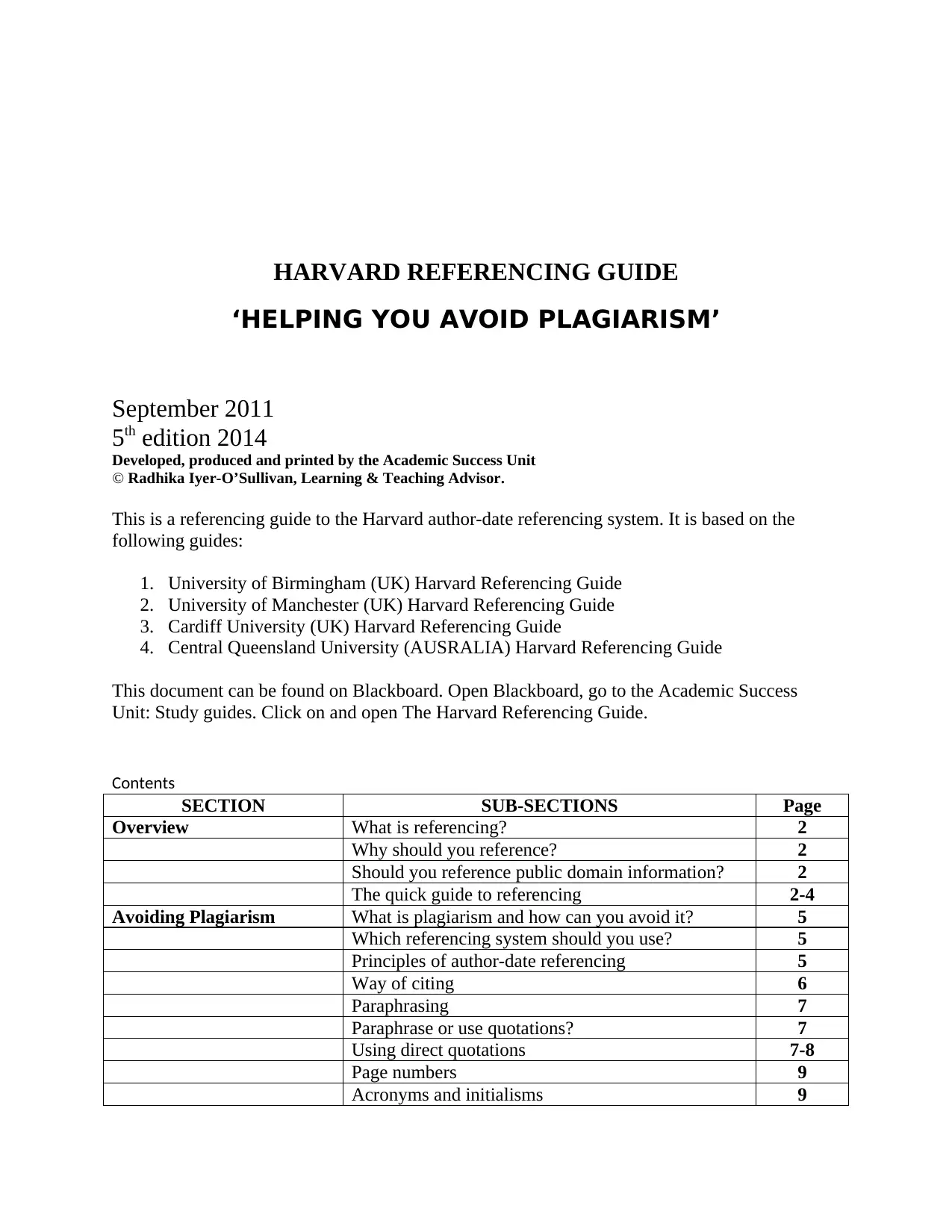
HARVARD REFERENCING GUIDE
‘HELPING YOU AVOID PLAGIARISM’
September 2011
5th edition 2014
Developed, produced and printed by the Academic Success Unit
© Radhika Iyer-O’Sullivan, Learning & Teaching Advisor.
This is a referencing guide to the Harvard author-date referencing system. It is based on the
following guides:
1. University of Birmingham (UK) Harvard Referencing Guide
2. University of Manchester (UK) Harvard Referencing Guide
3. Cardiff University (UK) Harvard Referencing Guide
4. Central Queensland University (AUSRALIA) Harvard Referencing Guide
This document can be found on Blackboard. Open Blackboard, go to the Academic Success
Unit: Study guides. Click on and open The Harvard Referencing Guide.
Contents
SECTION SUB-SECTIONS Page
Overview What is referencing? 2
Why should you reference? 2
Should you reference public domain information? 2
The quick guide to referencing 2-4
Avoiding Plagiarism What is plagiarism and how can you avoid it? 5
Which referencing system should you use? 5
Principles of author-date referencing 5
Way of citing 6
Paraphrasing 7
Paraphrase or use quotations? 7
Using direct quotations 7-8
Page numbers 9
Acronyms and initialisms 9
‘HELPING YOU AVOID PLAGIARISM’
September 2011
5th edition 2014
Developed, produced and printed by the Academic Success Unit
© Radhika Iyer-O’Sullivan, Learning & Teaching Advisor.
This is a referencing guide to the Harvard author-date referencing system. It is based on the
following guides:
1. University of Birmingham (UK) Harvard Referencing Guide
2. University of Manchester (UK) Harvard Referencing Guide
3. Cardiff University (UK) Harvard Referencing Guide
4. Central Queensland University (AUSRALIA) Harvard Referencing Guide
This document can be found on Blackboard. Open Blackboard, go to the Academic Success
Unit: Study guides. Click on and open The Harvard Referencing Guide.
Contents
SECTION SUB-SECTIONS Page
Overview What is referencing? 2
Why should you reference? 2
Should you reference public domain information? 2
The quick guide to referencing 2-4
Avoiding Plagiarism What is plagiarism and how can you avoid it? 5
Which referencing system should you use? 5
Principles of author-date referencing 5
Way of citing 6
Paraphrasing 7
Paraphrase or use quotations? 7
Using direct quotations 7-8
Page numbers 9
Acronyms and initialisms 9
Paraphrase This Document
Need a fresh take? Get an instant paraphrase of this document with our AI Paraphraser
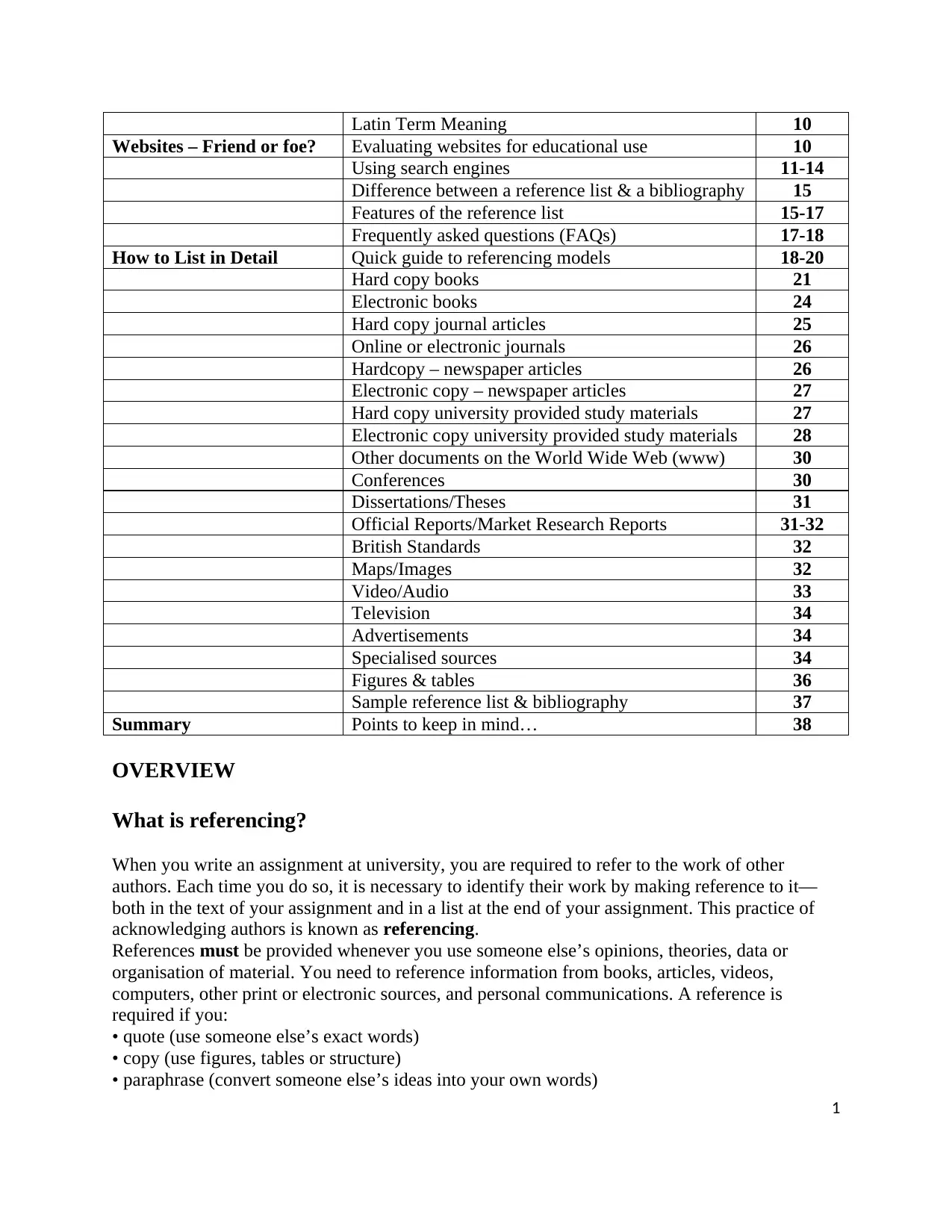
Latin Term Meaning 10
Websites – Friend or foe? Evaluating websites for educational use 10
Using search engines 11-14
Difference between a reference list & a bibliography 15
Features of the reference list 15-17
Frequently asked questions (FAQs) 17-18
How to List in Detail Quick guide to referencing models 18-20
Hard copy books 21
Electronic books 24
Hard copy journal articles 25
Online or electronic journals 26
Hardcopy – newspaper articles 26
Electronic copy – newspaper articles 27
Hard copy university provided study materials 27
Electronic copy university provided study materials 28
Other documents on the World Wide Web (www) 30
Conferences 30
Dissertations/Theses 31
Official Reports/Market Research Reports 31-32
British Standards 32
Maps/Images 32
Video/Audio 33
Television 34
Advertisements 34
Specialised sources 34
Figures & tables 36
Sample reference list & bibliography 37
Summary Points to keep in mind… 38
OVERVIEW
What is referencing?
When you write an assignment at university, you are required to refer to the work of other
authors. Each time you do so, it is necessary to identify their work by making reference to it—
both in the text of your assignment and in a list at the end of your assignment. This practice of
acknowledging authors is known as referencing.
References must be provided whenever you use someone else’s opinions, theories, data or
organisation of material. You need to reference information from books, articles, videos,
computers, other print or electronic sources, and personal communications. A reference is
required if you:
• quote (use someone else’s exact words)
• copy (use figures, tables or structure)
• paraphrase (convert someone else’s ideas into your own words)
1
Websites – Friend or foe? Evaluating websites for educational use 10
Using search engines 11-14
Difference between a reference list & a bibliography 15
Features of the reference list 15-17
Frequently asked questions (FAQs) 17-18
How to List in Detail Quick guide to referencing models 18-20
Hard copy books 21
Electronic books 24
Hard copy journal articles 25
Online or electronic journals 26
Hardcopy – newspaper articles 26
Electronic copy – newspaper articles 27
Hard copy university provided study materials 27
Electronic copy university provided study materials 28
Other documents on the World Wide Web (www) 30
Conferences 30
Dissertations/Theses 31
Official Reports/Market Research Reports 31-32
British Standards 32
Maps/Images 32
Video/Audio 33
Television 34
Advertisements 34
Specialised sources 34
Figures & tables 36
Sample reference list & bibliography 37
Summary Points to keep in mind… 38
OVERVIEW
What is referencing?
When you write an assignment at university, you are required to refer to the work of other
authors. Each time you do so, it is necessary to identify their work by making reference to it—
both in the text of your assignment and in a list at the end of your assignment. This practice of
acknowledging authors is known as referencing.
References must be provided whenever you use someone else’s opinions, theories, data or
organisation of material. You need to reference information from books, articles, videos,
computers, other print or electronic sources, and personal communications. A reference is
required if you:
• quote (use someone else’s exact words)
• copy (use figures, tables or structure)
• paraphrase (convert someone else’s ideas into your own words)
1
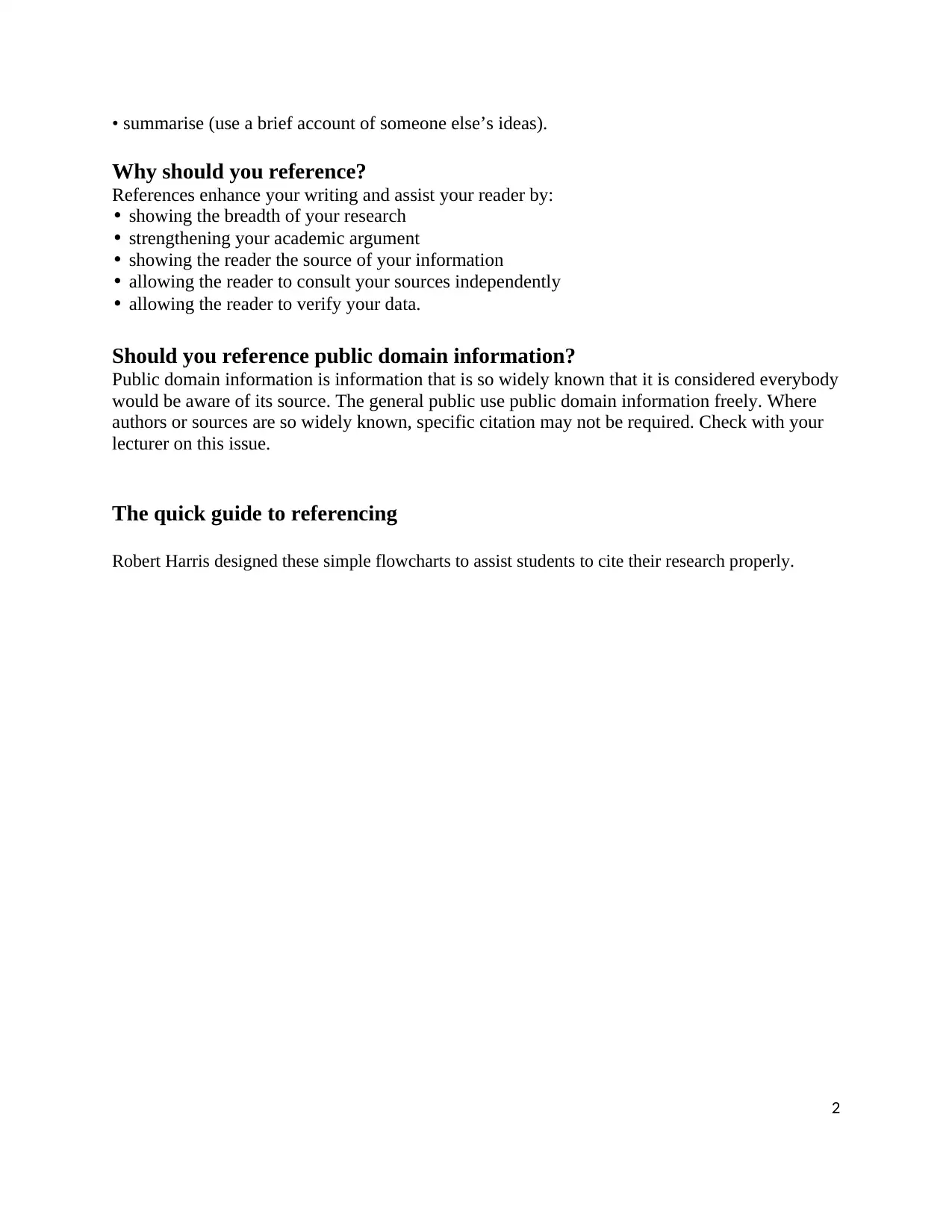
• summarise (use a brief account of someone else’s ideas).
Why should you reference?
References enhance your writing and assist your reader by:
• showing the breadth of your research
• strengthening your academic argument
• showing the reader the source of your information
• allowing the reader to consult your sources independently
• allowing the reader to verify your data.
Should you reference public domain information?
Public domain information is information that is so widely known that it is considered everybody
would be aware of its source. The general public use public domain information freely. Where
authors or sources are so widely known, specific citation may not be required. Check with your
lecturer on this issue.
The quick guide to referencing
Robert Harris designed these simple flowcharts to assist students to cite their research properly.
2
Why should you reference?
References enhance your writing and assist your reader by:
• showing the breadth of your research
• strengthening your academic argument
• showing the reader the source of your information
• allowing the reader to consult your sources independently
• allowing the reader to verify your data.
Should you reference public domain information?
Public domain information is information that is so widely known that it is considered everybody
would be aware of its source. The general public use public domain information freely. Where
authors or sources are so widely known, specific citation may not be required. Check with your
lecturer on this issue.
The quick guide to referencing
Robert Harris designed these simple flowcharts to assist students to cite their research properly.
2
⊘ This is a preview!⊘
Do you want full access?
Subscribe today to unlock all pages.

Trusted by 1+ million students worldwide
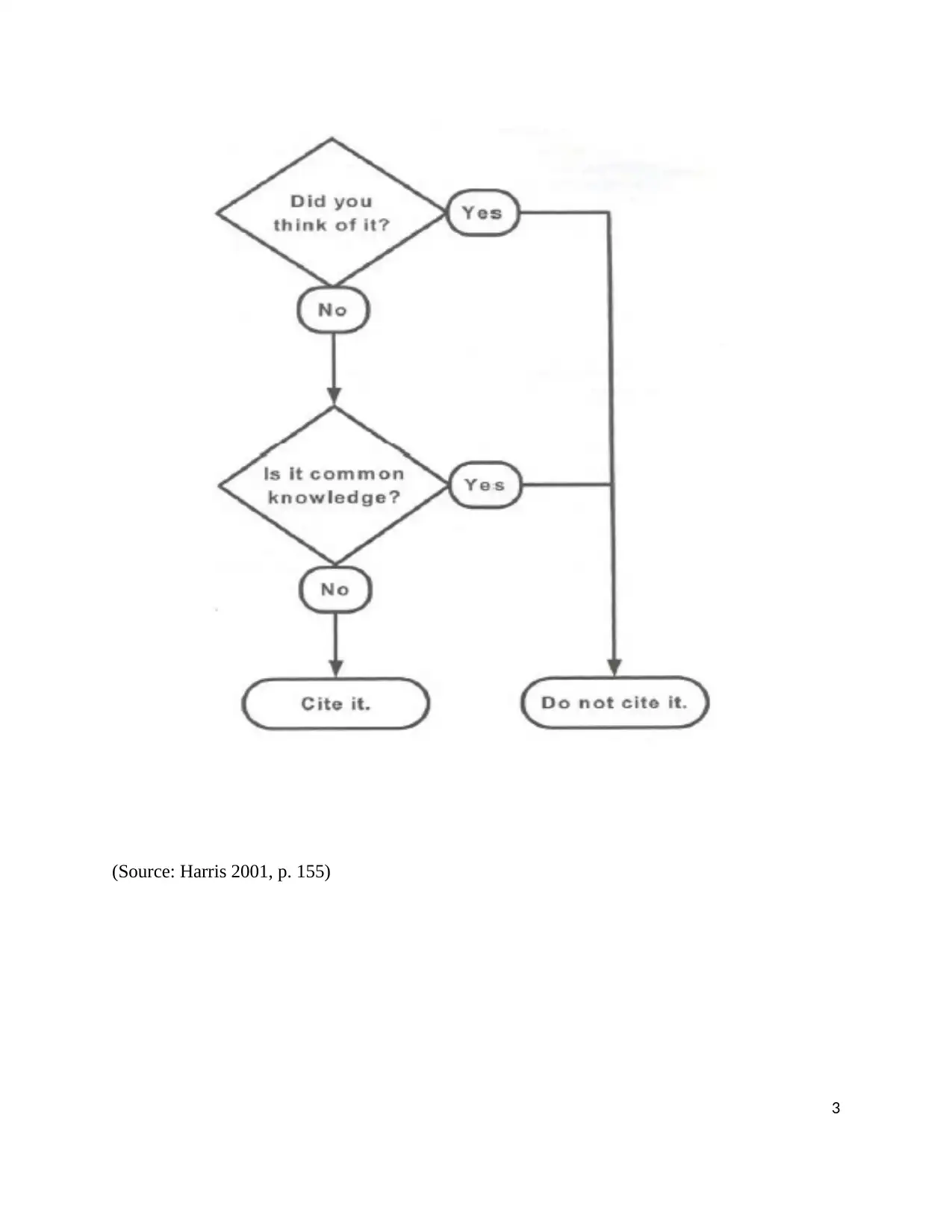
(Source: Harris 2001, p. 155)
3
3
Paraphrase This Document
Need a fresh take? Get an instant paraphrase of this document with our AI Paraphraser
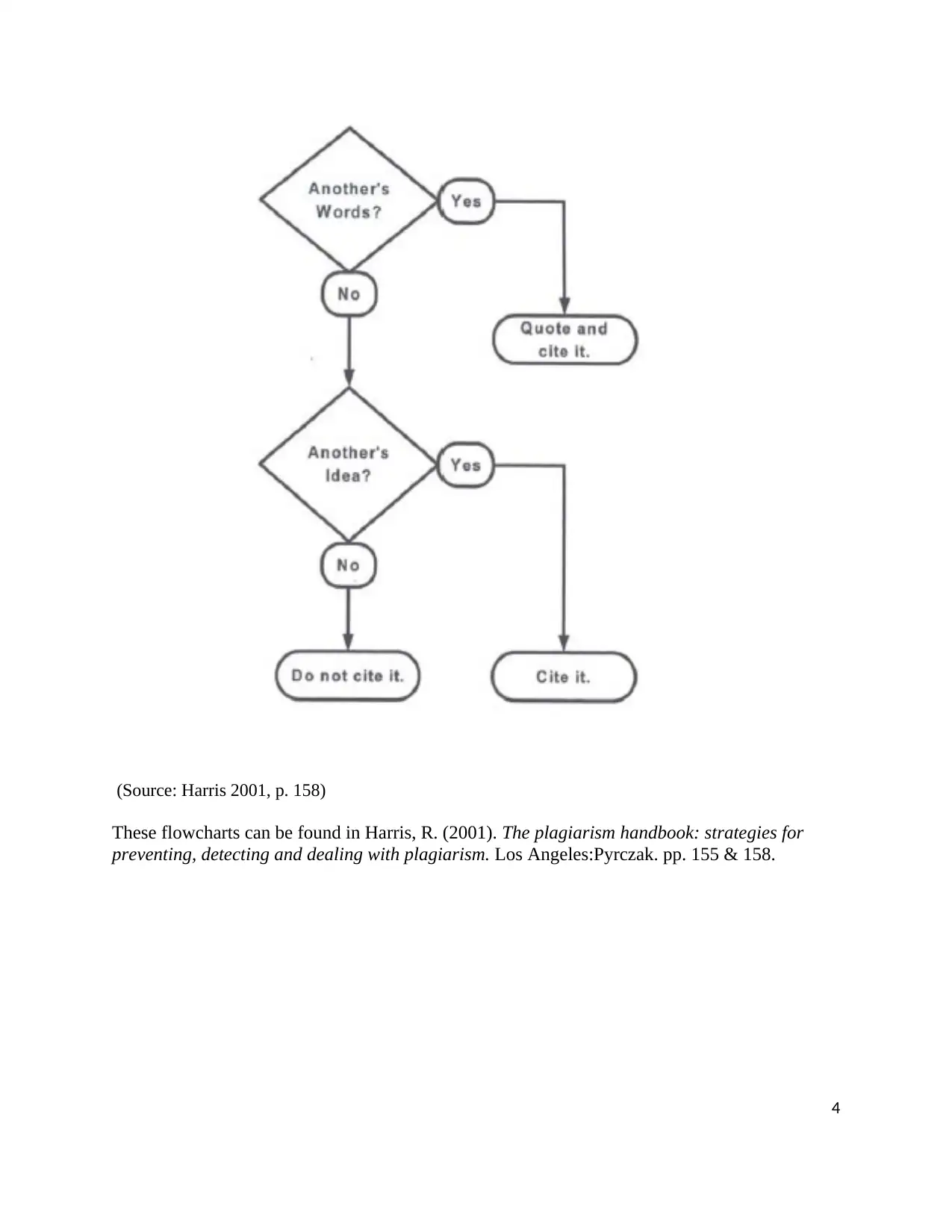
(Source: Harris 2001, p. 158)
These flowcharts can be found in Harris, R. (2001). The plagiarism handbook: strategies for
preventing, detecting and dealing with plagiarism. Los Angeles:Pyrczak. pp. 155 & 158.
4
These flowcharts can be found in Harris, R. (2001). The plagiarism handbook: strategies for
preventing, detecting and dealing with plagiarism. Los Angeles:Pyrczak. pp. 155 & 158.
4
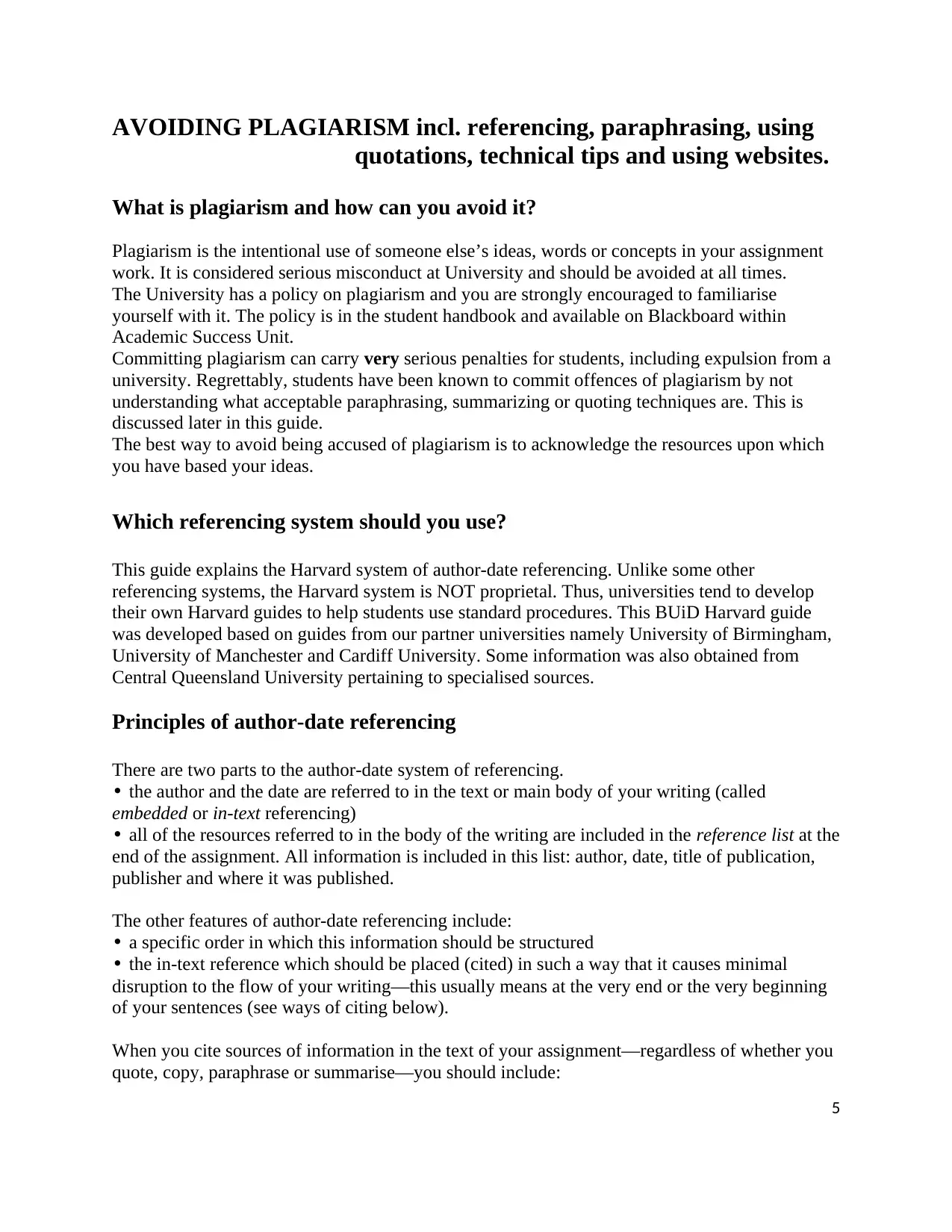
AVOIDING PLAGIARISM incl. referencing, paraphrasing, using
quotations, technical tips and using websites.
What is plagiarism and how can you avoid it?
Plagiarism is the intentional use of someone else’s ideas, words or concepts in your assignment
work. It is considered serious misconduct at University and should be avoided at all times.
The University has a policy on plagiarism and you are strongly encouraged to familiarise
yourself with it. The policy is in the student handbook and available on Blackboard within
Academic Success Unit.
Committing plagiarism can carry very serious penalties for students, including expulsion from a
university. Regrettably, students have been known to commit offences of plagiarism by not
understanding what acceptable paraphrasing, summarizing or quoting techniques are. This is
discussed later in this guide.
The best way to avoid being accused of plagiarism is to acknowledge the resources upon which
you have based your ideas.
Which referencing system should you use?
This guide explains the Harvard system of author-date referencing. Unlike some other
referencing systems, the Harvard system is NOT proprietal. Thus, universities tend to develop
their own Harvard guides to help students use standard procedures. This BUiD Harvard guide
was developed based on guides from our partner universities namely University of Birmingham,
University of Manchester and Cardiff University. Some information was also obtained from
Central Queensland University pertaining to specialised sources.
Principles of author-date referencing
There are two parts to the author-date system of referencing.
• the author and the date are referred to in the text or main body of your writing (called
embedded or in-text referencing)
• all of the resources referred to in the body of the writing are included in the reference list at the
end of the assignment. All information is included in this list: author, date, title of publication,
publisher and where it was published.
The other features of author-date referencing include:
• a specific order in which this information should be structured
• the in-text reference which should be placed (cited) in such a way that it causes minimal
disruption to the flow of your writing—this usually means at the very end or the very beginning
of your sentences (see ways of citing below).
When you cite sources of information in the text of your assignment—regardless of whether you
quote, copy, paraphrase or summarise—you should include:
5
quotations, technical tips and using websites.
What is plagiarism and how can you avoid it?
Plagiarism is the intentional use of someone else’s ideas, words or concepts in your assignment
work. It is considered serious misconduct at University and should be avoided at all times.
The University has a policy on plagiarism and you are strongly encouraged to familiarise
yourself with it. The policy is in the student handbook and available on Blackboard within
Academic Success Unit.
Committing plagiarism can carry very serious penalties for students, including expulsion from a
university. Regrettably, students have been known to commit offences of plagiarism by not
understanding what acceptable paraphrasing, summarizing or quoting techniques are. This is
discussed later in this guide.
The best way to avoid being accused of plagiarism is to acknowledge the resources upon which
you have based your ideas.
Which referencing system should you use?
This guide explains the Harvard system of author-date referencing. Unlike some other
referencing systems, the Harvard system is NOT proprietal. Thus, universities tend to develop
their own Harvard guides to help students use standard procedures. This BUiD Harvard guide
was developed based on guides from our partner universities namely University of Birmingham,
University of Manchester and Cardiff University. Some information was also obtained from
Central Queensland University pertaining to specialised sources.
Principles of author-date referencing
There are two parts to the author-date system of referencing.
• the author and the date are referred to in the text or main body of your writing (called
embedded or in-text referencing)
• all of the resources referred to in the body of the writing are included in the reference list at the
end of the assignment. All information is included in this list: author, date, title of publication,
publisher and where it was published.
The other features of author-date referencing include:
• a specific order in which this information should be structured
• the in-text reference which should be placed (cited) in such a way that it causes minimal
disruption to the flow of your writing—this usually means at the very end or the very beginning
of your sentences (see ways of citing below).
When you cite sources of information in the text of your assignment—regardless of whether you
quote, copy, paraphrase or summarise—you should include:
5
⊘ This is a preview!⊘
Do you want full access?
Subscribe today to unlock all pages.

Trusted by 1+ million students worldwide
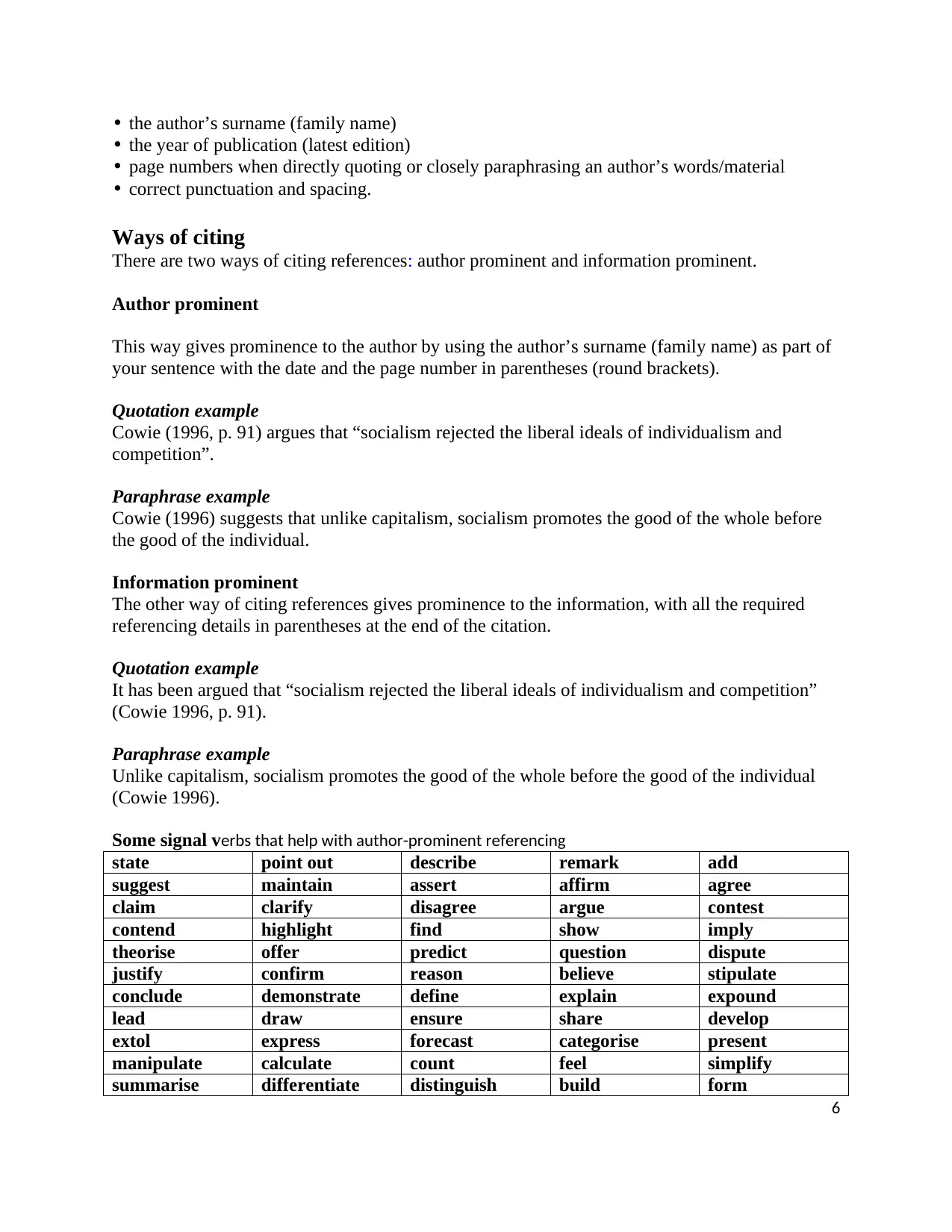
• the author’s surname (family name)
• the year of publication (latest edition)
• page numbers when directly quoting or closely paraphrasing an author’s words/material
• correct punctuation and spacing.
Ways of citing
There are two ways of citing references: author prominent and information prominent.
Author prominent
This way gives prominence to the author by using the author’s surname (family name) as part of
your sentence with the date and the page number in parentheses (round brackets).
Quotation example
Cowie (1996, p. 91) argues that “socialism rejected the liberal ideals of individualism and
competition”.
Paraphrase example
Cowie (1996) suggests that unlike capitalism, socialism promotes the good of the whole before
the good of the individual.
Information prominent
The other way of citing references gives prominence to the information, with all the required
referencing details in parentheses at the end of the citation.
Quotation example
It has been argued that “socialism rejected the liberal ideals of individualism and competition”
(Cowie 1996, p. 91).
Paraphrase example
Unlike capitalism, socialism promotes the good of the whole before the good of the individual
(Cowie 1996).
Some signal verbs that help with author-prominent referencing
state point out describe remark add
suggest maintain assert affirm agree
claim clarify disagree argue contest
contend highlight find show imply
theorise offer predict question dispute
justify confirm reason believe stipulate
conclude demonstrate define explain expound
lead draw ensure share develop
extol express forecast categorise present
manipulate calculate count feel simplify
summarise differentiate distinguish build form
6
• the year of publication (latest edition)
• page numbers when directly quoting or closely paraphrasing an author’s words/material
• correct punctuation and spacing.
Ways of citing
There are two ways of citing references: author prominent and information prominent.
Author prominent
This way gives prominence to the author by using the author’s surname (family name) as part of
your sentence with the date and the page number in parentheses (round brackets).
Quotation example
Cowie (1996, p. 91) argues that “socialism rejected the liberal ideals of individualism and
competition”.
Paraphrase example
Cowie (1996) suggests that unlike capitalism, socialism promotes the good of the whole before
the good of the individual.
Information prominent
The other way of citing references gives prominence to the information, with all the required
referencing details in parentheses at the end of the citation.
Quotation example
It has been argued that “socialism rejected the liberal ideals of individualism and competition”
(Cowie 1996, p. 91).
Paraphrase example
Unlike capitalism, socialism promotes the good of the whole before the good of the individual
(Cowie 1996).
Some signal verbs that help with author-prominent referencing
state point out describe remark add
suggest maintain assert affirm agree
claim clarify disagree argue contest
contend highlight find show imply
theorise offer predict question dispute
justify confirm reason believe stipulate
conclude demonstrate define explain expound
lead draw ensure share develop
extol express forecast categorise present
manipulate calculate count feel simplify
summarise differentiate distinguish build form
6
Paraphrase This Document
Need a fresh take? Get an instant paraphrase of this document with our AI Paraphraser
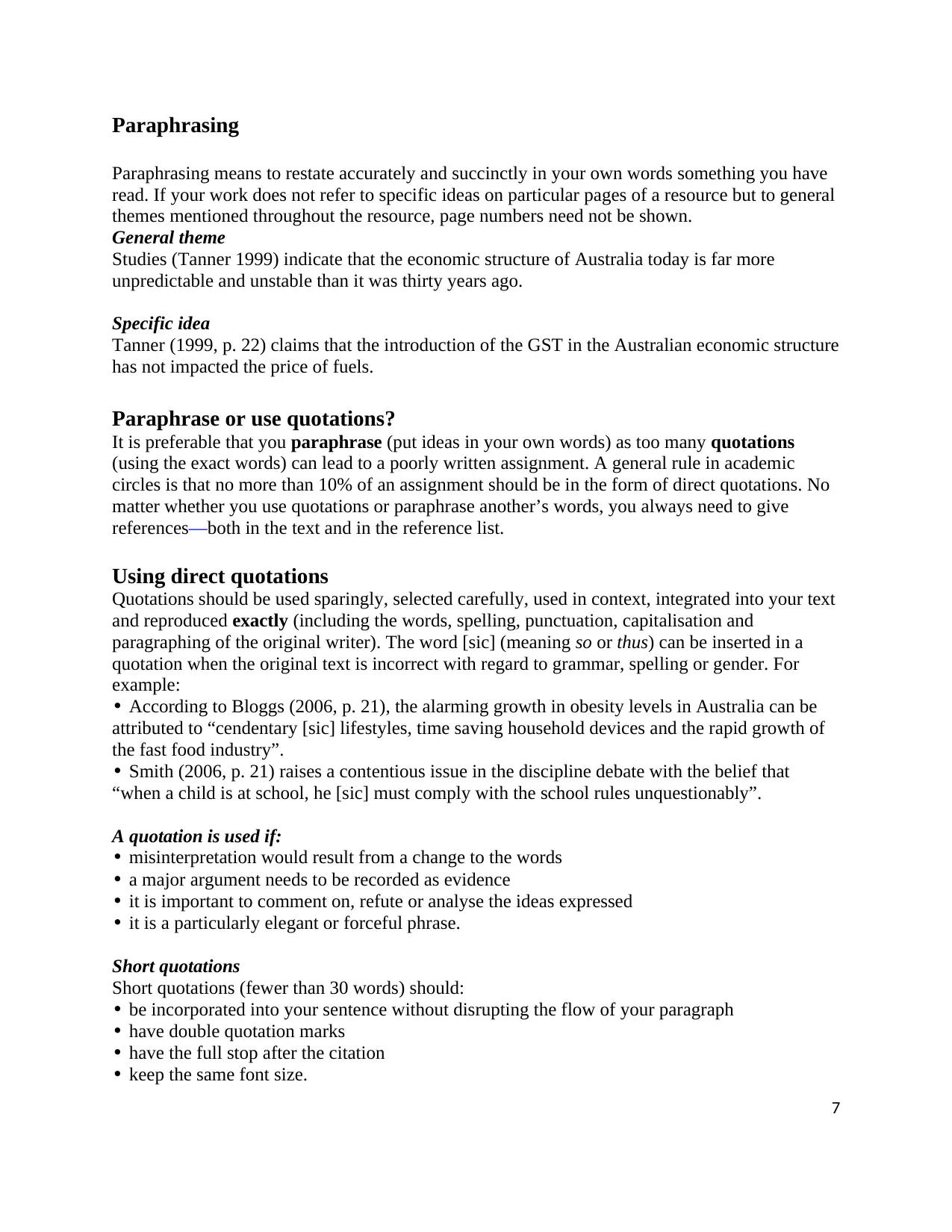
Paraphrasing
Paraphrasing means to restate accurately and succinctly in your own words something you have
read. If your work does not refer to specific ideas on particular pages of a resource but to general
themes mentioned throughout the resource, page numbers need not be shown.
General theme
Studies (Tanner 1999) indicate that the economic structure of Australia today is far more
unpredictable and unstable than it was thirty years ago.
Specific idea
Tanner (1999, p. 22) claims that the introduction of the GST in the Australian economic structure
has not impacted the price of fuels.
Paraphrase or use quotations?
It is preferable that you paraphrase (put ideas in your own words) as too many quotations
(using the exact words) can lead to a poorly written assignment. A general rule in academic
circles is that no more than 10% of an assignment should be in the form of direct quotations. No
matter whether you use quotations or paraphrase another’s words, you always need to give
references—both in the text and in the reference list.
Using direct quotations
Quotations should be used sparingly, selected carefully, used in context, integrated into your text
and reproduced exactly (including the words, spelling, punctuation, capitalisation and
paragraphing of the original writer). The word [sic] (meaning so or thus) can be inserted in a
quotation when the original text is incorrect with regard to grammar, spelling or gender. For
example:
• According to Bloggs (2006, p. 21), the alarming growth in obesity levels in Australia can be
attributed to “cendentary [sic] lifestyles, time saving household devices and the rapid growth of
the fast food industry”.
• Smith (2006, p. 21) raises a contentious issue in the discipline debate with the belief that
“when a child is at school, he [sic] must comply with the school rules unquestionably”.
A quotation is used if:
• misinterpretation would result from a change to the words
• a major argument needs to be recorded as evidence
• it is important to comment on, refute or analyse the ideas expressed
• it is a particularly elegant or forceful phrase.
Short quotations
Short quotations (fewer than 30 words) should:
• be incorporated into your sentence without disrupting the flow of your paragraph
• have double quotation marks
• have the full stop after the citation
• keep the same font size.
7
Paraphrasing means to restate accurately and succinctly in your own words something you have
read. If your work does not refer to specific ideas on particular pages of a resource but to general
themes mentioned throughout the resource, page numbers need not be shown.
General theme
Studies (Tanner 1999) indicate that the economic structure of Australia today is far more
unpredictable and unstable than it was thirty years ago.
Specific idea
Tanner (1999, p. 22) claims that the introduction of the GST in the Australian economic structure
has not impacted the price of fuels.
Paraphrase or use quotations?
It is preferable that you paraphrase (put ideas in your own words) as too many quotations
(using the exact words) can lead to a poorly written assignment. A general rule in academic
circles is that no more than 10% of an assignment should be in the form of direct quotations. No
matter whether you use quotations or paraphrase another’s words, you always need to give
references—both in the text and in the reference list.
Using direct quotations
Quotations should be used sparingly, selected carefully, used in context, integrated into your text
and reproduced exactly (including the words, spelling, punctuation, capitalisation and
paragraphing of the original writer). The word [sic] (meaning so or thus) can be inserted in a
quotation when the original text is incorrect with regard to grammar, spelling or gender. For
example:
• According to Bloggs (2006, p. 21), the alarming growth in obesity levels in Australia can be
attributed to “cendentary [sic] lifestyles, time saving household devices and the rapid growth of
the fast food industry”.
• Smith (2006, p. 21) raises a contentious issue in the discipline debate with the belief that
“when a child is at school, he [sic] must comply with the school rules unquestionably”.
A quotation is used if:
• misinterpretation would result from a change to the words
• a major argument needs to be recorded as evidence
• it is important to comment on, refute or analyse the ideas expressed
• it is a particularly elegant or forceful phrase.
Short quotations
Short quotations (fewer than 30 words) should:
• be incorporated into your sentence without disrupting the flow of your paragraph
• have double quotation marks
• have the full stop after the citation
• keep the same font size.
7
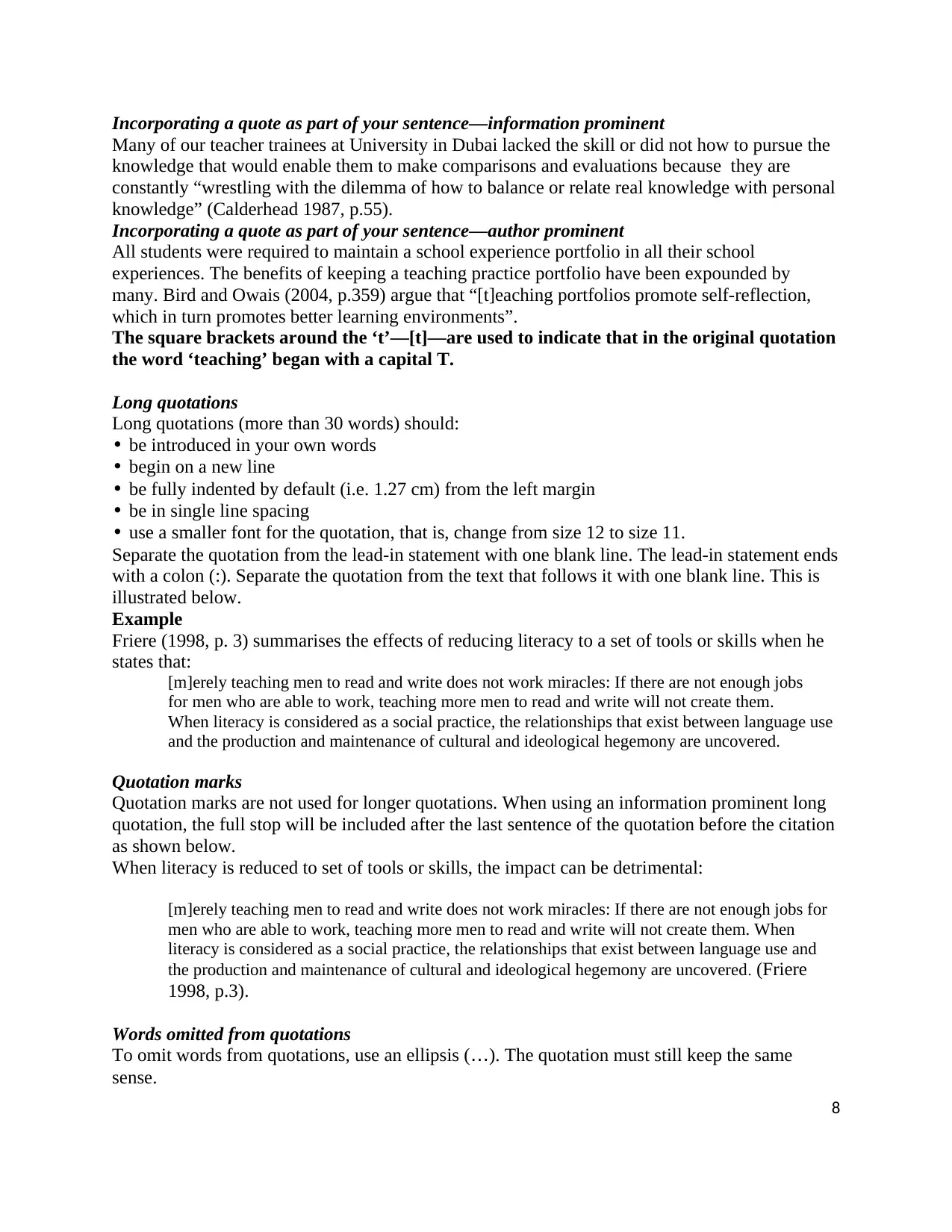
Incorporating a quote as part of your sentence—information prominent
Many of our teacher trainees at University in Dubai lacked the skill or did not how to pursue the
knowledge that would enable them to make comparisons and evaluations because they are
constantly “wrestling with the dilemma of how to balance or relate real knowledge with personal
knowledge” (Calderhead 1987, p.55).
Incorporating a quote as part of your sentence—author prominent
All students were required to maintain a school experience portfolio in all their school
experiences. The benefits of keeping a teaching practice portfolio have been expounded by
many. Bird and Owais (2004, p.359) argue that “[t]eaching portfolios promote self-reflection,
which in turn promotes better learning environments”.
The square brackets around the ‘t’—[t]—are used to indicate that in the original quotation
the word ‘teaching’ began with a capital T.
Long quotations
Long quotations (more than 30 words) should:
• be introduced in your own words
• begin on a new line
• be fully indented by default (i.e. 1.27 cm) from the left margin
• be in single line spacing
• use a smaller font for the quotation, that is, change from size 12 to size 11.
Separate the quotation from the lead-in statement with one blank line. The lead-in statement ends
with a colon (:). Separate the quotation from the text that follows it with one blank line. This is
illustrated below.
Example
Friere (1998, p. 3) summarises the effects of reducing literacy to a set of tools or skills when he
states that:
[m]erely teaching men to read and write does not work miracles: If there are not enough jobs
for men who are able to work, teaching more men to read and write will not create them.
When literacy is considered as a social practice, the relationships that exist between language use
and the production and maintenance of cultural and ideological hegemony are uncovered.
Quotation marks
Quotation marks are not used for longer quotations. When using an information prominent long
quotation, the full stop will be included after the last sentence of the quotation before the citation
as shown below.
When literacy is reduced to set of tools or skills, the impact can be detrimental:
[m]erely teaching men to read and write does not work miracles: If there are not enough jobs for
men who are able to work, teaching more men to read and write will not create them. When
literacy is considered as a social practice, the relationships that exist between language use and
the production and maintenance of cultural and ideological hegemony are uncovered. (Friere
1998, p.3).
Words omitted from quotations
To omit words from quotations, use an ellipsis (…). The quotation must still keep the same
sense.
8
Many of our teacher trainees at University in Dubai lacked the skill or did not how to pursue the
knowledge that would enable them to make comparisons and evaluations because they are
constantly “wrestling with the dilemma of how to balance or relate real knowledge with personal
knowledge” (Calderhead 1987, p.55).
Incorporating a quote as part of your sentence—author prominent
All students were required to maintain a school experience portfolio in all their school
experiences. The benefits of keeping a teaching practice portfolio have been expounded by
many. Bird and Owais (2004, p.359) argue that “[t]eaching portfolios promote self-reflection,
which in turn promotes better learning environments”.
The square brackets around the ‘t’—[t]—are used to indicate that in the original quotation
the word ‘teaching’ began with a capital T.
Long quotations
Long quotations (more than 30 words) should:
• be introduced in your own words
• begin on a new line
• be fully indented by default (i.e. 1.27 cm) from the left margin
• be in single line spacing
• use a smaller font for the quotation, that is, change from size 12 to size 11.
Separate the quotation from the lead-in statement with one blank line. The lead-in statement ends
with a colon (:). Separate the quotation from the text that follows it with one blank line. This is
illustrated below.
Example
Friere (1998, p. 3) summarises the effects of reducing literacy to a set of tools or skills when he
states that:
[m]erely teaching men to read and write does not work miracles: If there are not enough jobs
for men who are able to work, teaching more men to read and write will not create them.
When literacy is considered as a social practice, the relationships that exist between language use
and the production and maintenance of cultural and ideological hegemony are uncovered.
Quotation marks
Quotation marks are not used for longer quotations. When using an information prominent long
quotation, the full stop will be included after the last sentence of the quotation before the citation
as shown below.
When literacy is reduced to set of tools or skills, the impact can be detrimental:
[m]erely teaching men to read and write does not work miracles: If there are not enough jobs for
men who are able to work, teaching more men to read and write will not create them. When
literacy is considered as a social practice, the relationships that exist between language use and
the production and maintenance of cultural and ideological hegemony are uncovered. (Friere
1998, p.3).
Words omitted from quotations
To omit words from quotations, use an ellipsis (…). The quotation must still keep the same
sense.
8
⊘ This is a preview!⊘
Do you want full access?
Subscribe today to unlock all pages.

Trusted by 1+ million students worldwide
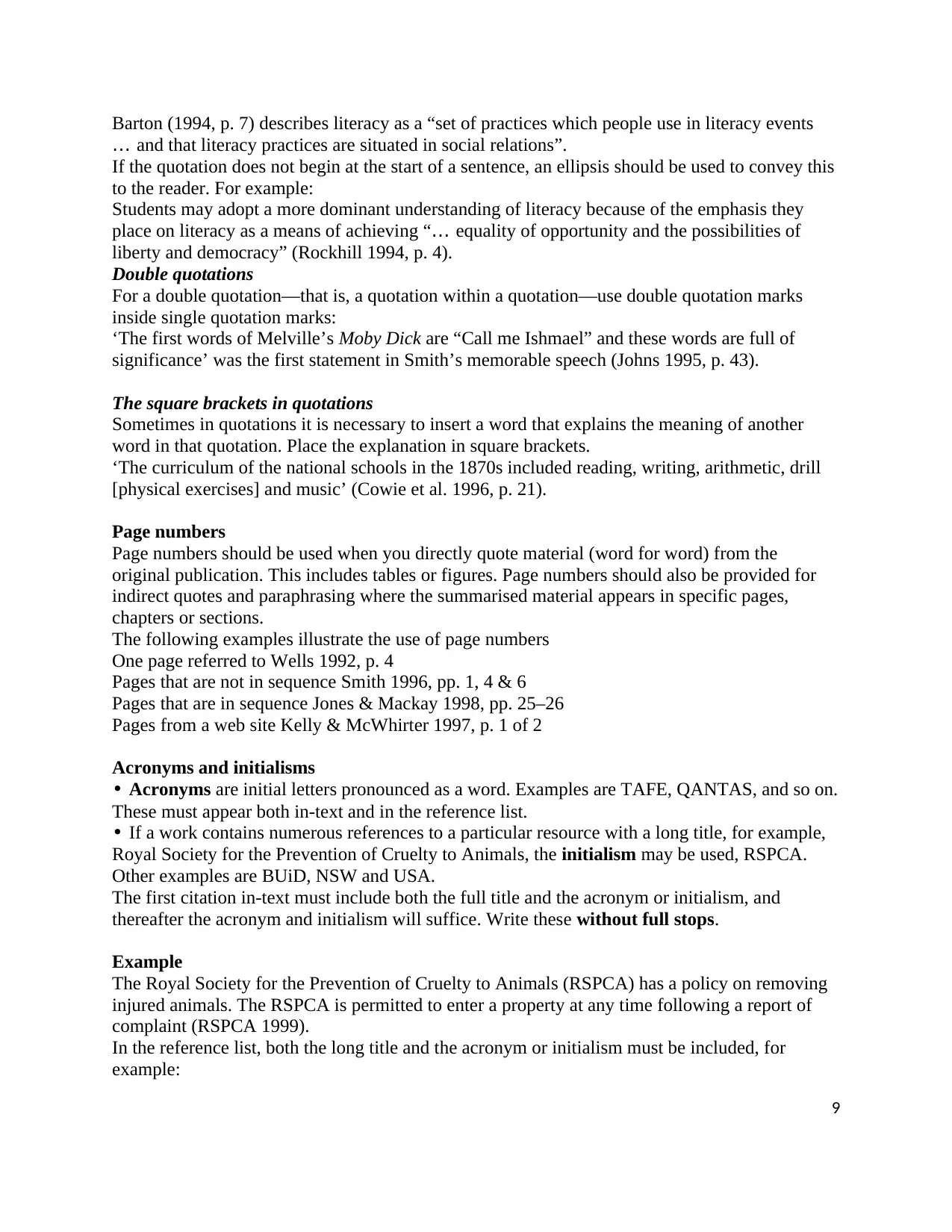
Barton (1994, p. 7) describes literacy as a “set of practices which people use in literacy events
… and that literacy practices are situated in social relations”.
If the quotation does not begin at the start of a sentence, an ellipsis should be used to convey this
to the reader. For example:
Students may adopt a more dominant understanding of literacy because of the emphasis they
place on literacy as a means of achieving “… equality of opportunity and the possibilities of
liberty and democracy” (Rockhill 1994, p. 4).
Double quotations
For a double quotation—that is, a quotation within a quotation—use double quotation marks
inside single quotation marks:
‘The first words of Melville’s Moby Dick are “Call me Ishmael” and these words are full of
significance’ was the first statement in Smith’s memorable speech (Johns 1995, p. 43).
The square brackets in quotations
Sometimes in quotations it is necessary to insert a word that explains the meaning of another
word in that quotation. Place the explanation in square brackets.
‘The curriculum of the national schools in the 1870s included reading, writing, arithmetic, drill
[physical exercises] and music’ (Cowie et al. 1996, p. 21).
Page numbers
Page numbers should be used when you directly quote material (word for word) from the
original publication. This includes tables or figures. Page numbers should also be provided for
indirect quotes and paraphrasing where the summarised material appears in specific pages,
chapters or sections.
The following examples illustrate the use of page numbers
One page referred to Wells 1992, p. 4
Pages that are not in sequence Smith 1996, pp. 1, 4 & 6
Pages that are in sequence Jones & Mackay 1998, pp. 25–26
Pages from a web site Kelly & McWhirter 1997, p. 1 of 2
Acronyms and initialisms
• Acronyms are initial letters pronounced as a word. Examples are TAFE, QANTAS, and so on.
These must appear both in-text and in the reference list.
• If a work contains numerous references to a particular resource with a long title, for example,
Royal Society for the Prevention of Cruelty to Animals, the initialism may be used, RSPCA.
Other examples are BUiD, NSW and USA.
The first citation in-text must include both the full title and the acronym or initialism, and
thereafter the acronym and initialism will suffice. Write these without full stops.
Example
The Royal Society for the Prevention of Cruelty to Animals (RSPCA) has a policy on removing
injured animals. The RSPCA is permitted to enter a property at any time following a report of
complaint (RSPCA 1999).
In the reference list, both the long title and the acronym or initialism must be included, for
example:
9
… and that literacy practices are situated in social relations”.
If the quotation does not begin at the start of a sentence, an ellipsis should be used to convey this
to the reader. For example:
Students may adopt a more dominant understanding of literacy because of the emphasis they
place on literacy as a means of achieving “… equality of opportunity and the possibilities of
liberty and democracy” (Rockhill 1994, p. 4).
Double quotations
For a double quotation—that is, a quotation within a quotation—use double quotation marks
inside single quotation marks:
‘The first words of Melville’s Moby Dick are “Call me Ishmael” and these words are full of
significance’ was the first statement in Smith’s memorable speech (Johns 1995, p. 43).
The square brackets in quotations
Sometimes in quotations it is necessary to insert a word that explains the meaning of another
word in that quotation. Place the explanation in square brackets.
‘The curriculum of the national schools in the 1870s included reading, writing, arithmetic, drill
[physical exercises] and music’ (Cowie et al. 1996, p. 21).
Page numbers
Page numbers should be used when you directly quote material (word for word) from the
original publication. This includes tables or figures. Page numbers should also be provided for
indirect quotes and paraphrasing where the summarised material appears in specific pages,
chapters or sections.
The following examples illustrate the use of page numbers
One page referred to Wells 1992, p. 4
Pages that are not in sequence Smith 1996, pp. 1, 4 & 6
Pages that are in sequence Jones & Mackay 1998, pp. 25–26
Pages from a web site Kelly & McWhirter 1997, p. 1 of 2
Acronyms and initialisms
• Acronyms are initial letters pronounced as a word. Examples are TAFE, QANTAS, and so on.
These must appear both in-text and in the reference list.
• If a work contains numerous references to a particular resource with a long title, for example,
Royal Society for the Prevention of Cruelty to Animals, the initialism may be used, RSPCA.
Other examples are BUiD, NSW and USA.
The first citation in-text must include both the full title and the acronym or initialism, and
thereafter the acronym and initialism will suffice. Write these without full stops.
Example
The Royal Society for the Prevention of Cruelty to Animals (RSPCA) has a policy on removing
injured animals. The RSPCA is permitted to enter a property at any time following a report of
complaint (RSPCA 1999).
In the reference list, both the long title and the acronym or initialism must be included, for
example:
9
Paraphrase This Document
Need a fresh take? Get an instant paraphrase of this document with our AI Paraphraser
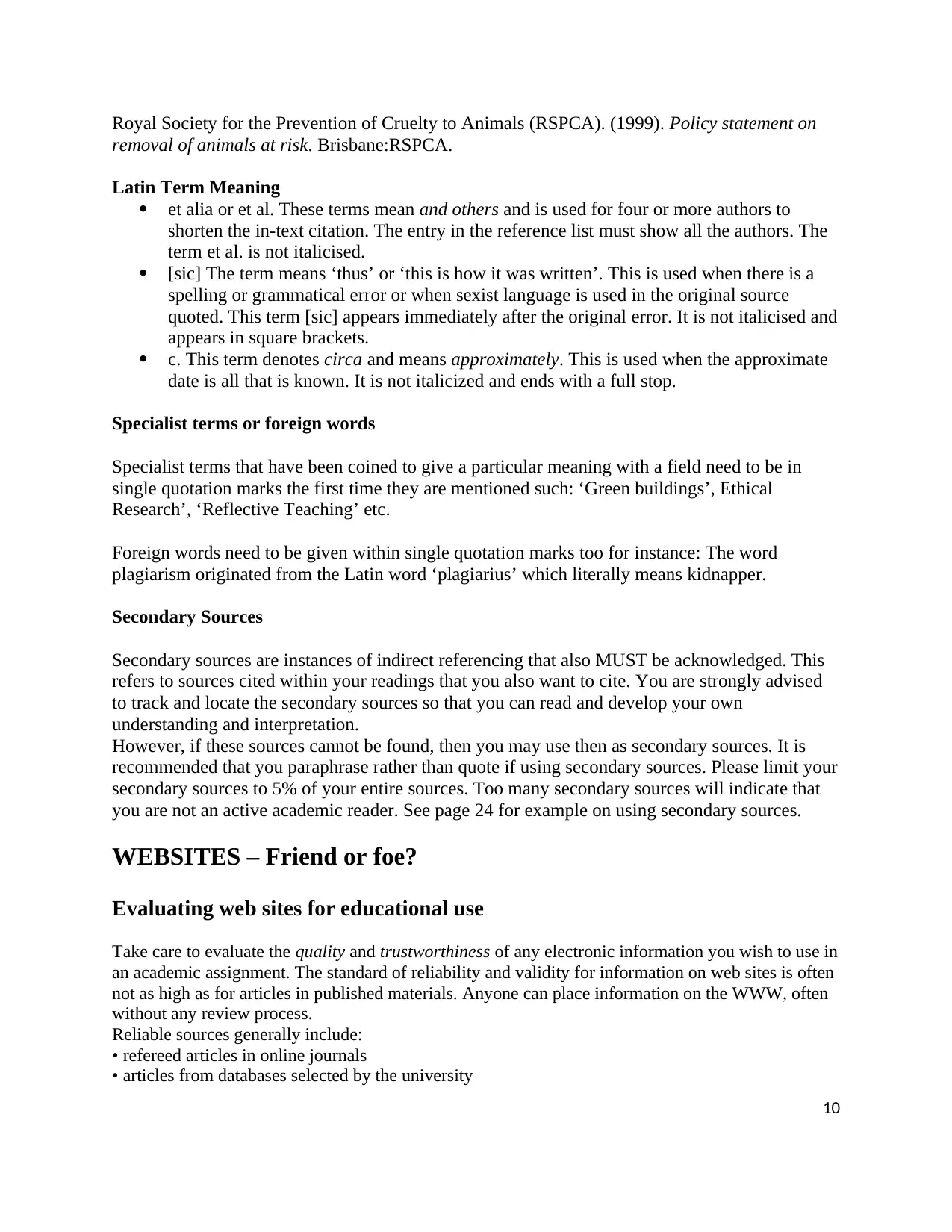
Royal Society for the Prevention of Cruelty to Animals (RSPCA). (1999). Policy statement on
removal of animals at risk. Brisbane:RSPCA.
Latin Term Meaning
et alia or et al. These terms mean and others and is used for four or more authors to
shorten the in-text citation. The entry in the reference list must show all the authors. The
term et al. is not italicised.
[sic] The term means ‘thus’ or ‘this is how it was written’. This is used when there is a
spelling or grammatical error or when sexist language is used in the original source
quoted. This term [sic] appears immediately after the original error. It is not italicised and
appears in square brackets.
c. This term denotes circa and means approximately. This is used when the approximate
date is all that is known. It is not italicized and ends with a full stop.
Specialist terms or foreign words
Specialist terms that have been coined to give a particular meaning with a field need to be in
single quotation marks the first time they are mentioned such: ‘Green buildings’, Ethical
Research’, ‘Reflective Teaching’ etc.
Foreign words need to be given within single quotation marks too for instance: The word
plagiarism originated from the Latin word ‘plagiarius’ which literally means kidnapper.
Secondary Sources
Secondary sources are instances of indirect referencing that also MUST be acknowledged. This
refers to sources cited within your readings that you also want to cite. You are strongly advised
to track and locate the secondary sources so that you can read and develop your own
understanding and interpretation.
However, if these sources cannot be found, then you may use then as secondary sources. It is
recommended that you paraphrase rather than quote if using secondary sources. Please limit your
secondary sources to 5% of your entire sources. Too many secondary sources will indicate that
you are not an active academic reader. See page 24 for example on using secondary sources.
WEBSITES – Friend or foe?
Evaluating web sites for educational use
Take care to evaluate the quality and trustworthiness of any electronic information you wish to use in
an academic assignment. The standard of reliability and validity for information on web sites is often
not as high as for articles in published materials. Anyone can place information on the WWW, often
without any review process.
Reliable sources generally include:
• refereed articles in online journals
• articles from databases selected by the university
10
removal of animals at risk. Brisbane:RSPCA.
Latin Term Meaning
et alia or et al. These terms mean and others and is used for four or more authors to
shorten the in-text citation. The entry in the reference list must show all the authors. The
term et al. is not italicised.
[sic] The term means ‘thus’ or ‘this is how it was written’. This is used when there is a
spelling or grammatical error or when sexist language is used in the original source
quoted. This term [sic] appears immediately after the original error. It is not italicised and
appears in square brackets.
c. This term denotes circa and means approximately. This is used when the approximate
date is all that is known. It is not italicized and ends with a full stop.
Specialist terms or foreign words
Specialist terms that have been coined to give a particular meaning with a field need to be in
single quotation marks the first time they are mentioned such: ‘Green buildings’, Ethical
Research’, ‘Reflective Teaching’ etc.
Foreign words need to be given within single quotation marks too for instance: The word
plagiarism originated from the Latin word ‘plagiarius’ which literally means kidnapper.
Secondary Sources
Secondary sources are instances of indirect referencing that also MUST be acknowledged. This
refers to sources cited within your readings that you also want to cite. You are strongly advised
to track and locate the secondary sources so that you can read and develop your own
understanding and interpretation.
However, if these sources cannot be found, then you may use then as secondary sources. It is
recommended that you paraphrase rather than quote if using secondary sources. Please limit your
secondary sources to 5% of your entire sources. Too many secondary sources will indicate that
you are not an active academic reader. See page 24 for example on using secondary sources.
WEBSITES – Friend or foe?
Evaluating web sites for educational use
Take care to evaluate the quality and trustworthiness of any electronic information you wish to use in
an academic assignment. The standard of reliability and validity for information on web sites is often
not as high as for articles in published materials. Anyone can place information on the WWW, often
without any review process.
Reliable sources generally include:
• refereed articles in online journals
• articles from databases selected by the university
10
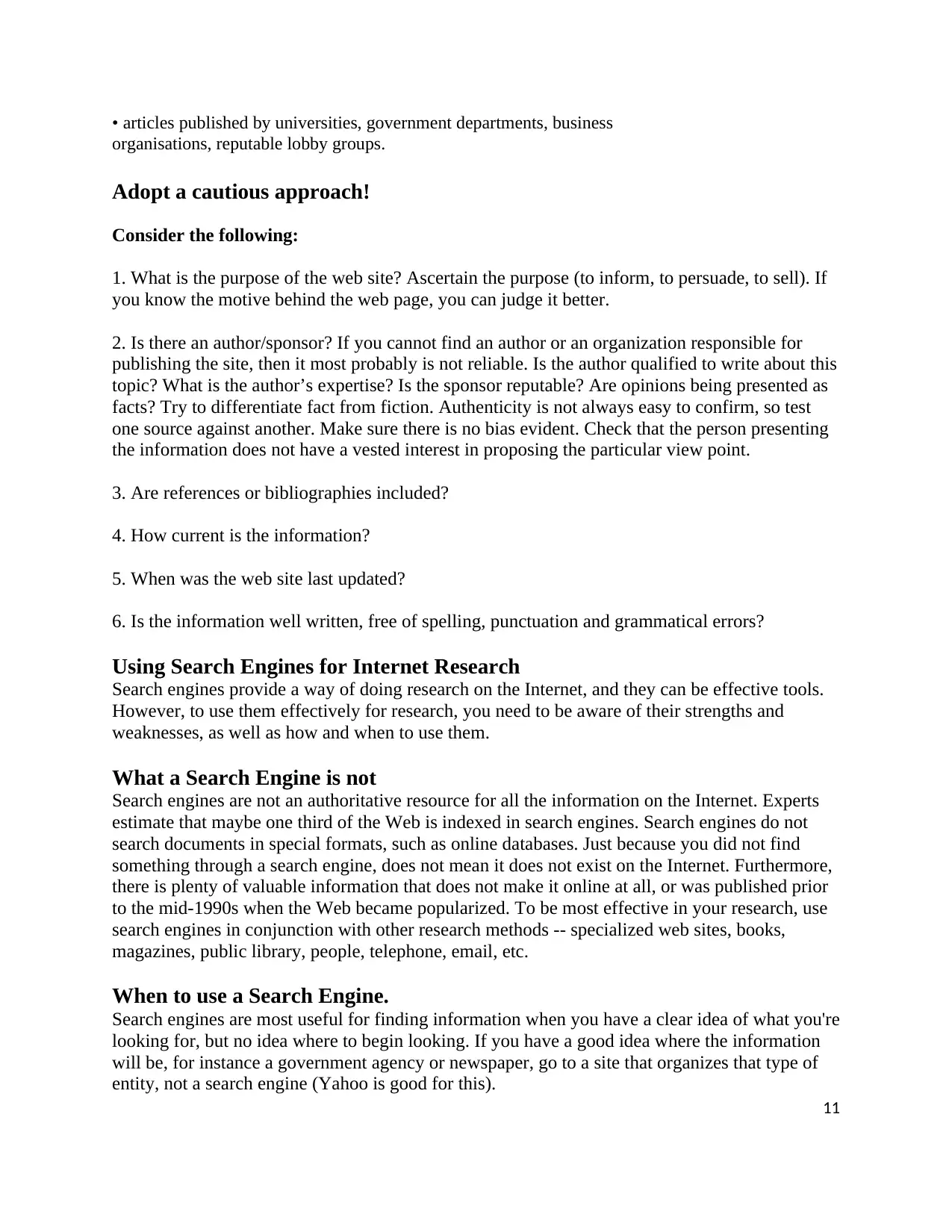
• articles published by universities, government departments, business
organisations, reputable lobby groups.
Adopt a cautious approach!
Consider the following:
1. What is the purpose of the web site? Ascertain the purpose (to inform, to persuade, to sell). If
you know the motive behind the web page, you can judge it better.
2. Is there an author/sponsor? If you cannot find an author or an organization responsible for
publishing the site, then it most probably is not reliable. Is the author qualified to write about this
topic? What is the author’s expertise? Is the sponsor reputable? Are opinions being presented as
facts? Try to differentiate fact from fiction. Authenticity is not always easy to confirm, so test
one source against another. Make sure there is no bias evident. Check that the person presenting
the information does not have a vested interest in proposing the particular view point.
3. Are references or bibliographies included?
4. How current is the information?
5. When was the web site last updated?
6. Is the information well written, free of spelling, punctuation and grammatical errors?
Using Search Engines for Internet Research
Search engines provide a way of doing research on the Internet, and they can be effective tools.
However, to use them effectively for research, you need to be aware of their strengths and
weaknesses, as well as how and when to use them.
What a Search Engine is not
Search engines are not an authoritative resource for all the information on the Internet. Experts
estimate that maybe one third of the Web is indexed in search engines. Search engines do not
search documents in special formats, such as online databases. Just because you did not find
something through a search engine, does not mean it does not exist on the Internet. Furthermore,
there is plenty of valuable information that does not make it online at all, or was published prior
to the mid-1990s when the Web became popularized. To be most effective in your research, use
search engines in conjunction with other research methods -- specialized web sites, books,
magazines, public library, people, telephone, email, etc.
When to use a Search Engine.
Search engines are most useful for finding information when you have a clear idea of what you're
looking for, but no idea where to begin looking. If you have a good idea where the information
will be, for instance a government agency or newspaper, go to a site that organizes that type of
entity, not a search engine (Yahoo is good for this).
11
organisations, reputable lobby groups.
Adopt a cautious approach!
Consider the following:
1. What is the purpose of the web site? Ascertain the purpose (to inform, to persuade, to sell). If
you know the motive behind the web page, you can judge it better.
2. Is there an author/sponsor? If you cannot find an author or an organization responsible for
publishing the site, then it most probably is not reliable. Is the author qualified to write about this
topic? What is the author’s expertise? Is the sponsor reputable? Are opinions being presented as
facts? Try to differentiate fact from fiction. Authenticity is not always easy to confirm, so test
one source against another. Make sure there is no bias evident. Check that the person presenting
the information does not have a vested interest in proposing the particular view point.
3. Are references or bibliographies included?
4. How current is the information?
5. When was the web site last updated?
6. Is the information well written, free of spelling, punctuation and grammatical errors?
Using Search Engines for Internet Research
Search engines provide a way of doing research on the Internet, and they can be effective tools.
However, to use them effectively for research, you need to be aware of their strengths and
weaknesses, as well as how and when to use them.
What a Search Engine is not
Search engines are not an authoritative resource for all the information on the Internet. Experts
estimate that maybe one third of the Web is indexed in search engines. Search engines do not
search documents in special formats, such as online databases. Just because you did not find
something through a search engine, does not mean it does not exist on the Internet. Furthermore,
there is plenty of valuable information that does not make it online at all, or was published prior
to the mid-1990s when the Web became popularized. To be most effective in your research, use
search engines in conjunction with other research methods -- specialized web sites, books,
magazines, public library, people, telephone, email, etc.
When to use a Search Engine.
Search engines are most useful for finding information when you have a clear idea of what you're
looking for, but no idea where to begin looking. If you have a good idea where the information
will be, for instance a government agency or newspaper, go to a site that organizes that type of
entity, not a search engine (Yahoo is good for this).
11
⊘ This is a preview!⊘
Do you want full access?
Subscribe today to unlock all pages.

Trusted by 1+ million students worldwide
1 out of 39
Related Documents
Your All-in-One AI-Powered Toolkit for Academic Success.
+13062052269
info@desklib.com
Available 24*7 on WhatsApp / Email
![[object Object]](/_next/static/media/star-bottom.7253800d.svg)
Unlock your academic potential
Copyright © 2020–2025 A2Z Services. All Rights Reserved. Developed and managed by ZUCOL.





